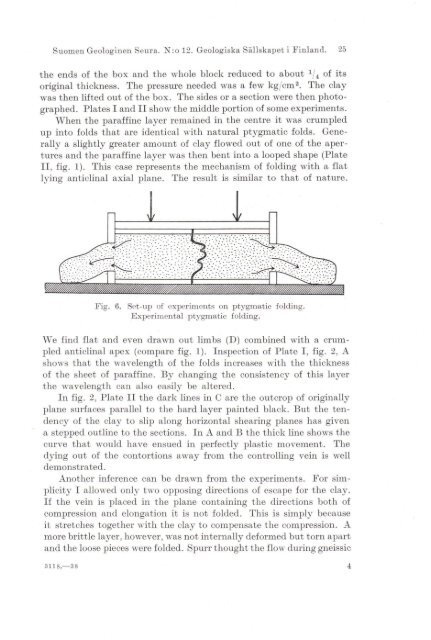GOHMISSION GEOLOGIQVE - Arkisto.gsf.fi
GOHMISSION GEOLOGIQVE - Arkisto.gsf.fi
GOHMISSION GEOLOGIQVE - Arkisto.gsf.fi
Create successful ePaper yourself
Turn your PDF publications into a flip-book with our unique Google optimized e-Paper software.
Suomen Geologinen Seura. N:o 12. Geologiska Sallskapet i Finland. 25<br />
the ends of the box and the whole block reduced to about l/, of its<br />
original thickness. The pressure needed was a few kg/cm2. The clay<br />
was then lifted out of the box. The sides or a section were then photographed.<br />
Plates 1 and II show the middle portion of some experiments.<br />
When the paraf<strong>fi</strong>ne layer remained in the centre it was crumpled<br />
up into folds that are identical with natural ptygmatic folds. Generally<br />
a slightly greater amount of clay flowed out of one of the apertures<br />
and the paraf<strong>fi</strong>ne layer was then bent into a looped shape (Plate<br />
II, <strong>fi</strong>g. 1). This case represents the mechanism of folding with a flat<br />
lying anticlinal axial plane. The result is similar to that of nature.<br />
Fig. 6. Set-up of experimenta on ptygmatic folding.<br />
Experimental ptygmatic folding.<br />
We <strong>fi</strong>nd flat and even drawn out limbs (D) combined with a crumpled<br />
anticlinal apex (compare <strong>fi</strong>g. 1). Inspection of Plate 1, <strong>fi</strong>g. 2, A<br />
shows that the wavelength of the folds increases with the thickness<br />
of $he sheet of paraf<strong>fi</strong>ne. By changing the consistency of this layer<br />
the wavelength can also easily be altered.<br />
In <strong>fi</strong>g. 2, Plate II the dark lines in C are the outcrop of originally<br />
plane surfaces parallel to the hard layer painted black. But the tendency<br />
of the clay to slip along horizontal shearing planes hae given<br />
. a stepped outline to the sections. In A and B the thick line shows the<br />
curve that would have ensued in perfectly plastic movement. The<br />
dying out of the contortions away from the controlling vein is well<br />
demonstrated.<br />
Another inference can be drawn from the experiments. For simplicity<br />
1 allowed only two opposing directions of escape for the clay.<br />
If the vein is placed in the plane containing the directions both of<br />
compression and elongation it is not folded. This is sirnply because<br />
it stretches together with the clay to compensate the compression. A<br />
more brittle layer, however, was not internally deformed but torn apart<br />
and the loose pieces were folded. Spurr thought the flow during gneissic
















